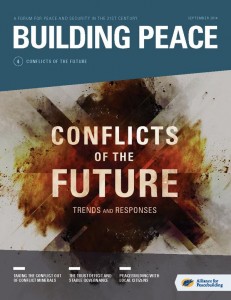A BLOG POST BY JESSICA BERNS, EDITOR-IN-CHIEF OF BUILDING PEACE

In our March 2014 issue of Building Peace magazine we wrote, “The conversation about gender and peacebuilding is actually about inclusion and participation: social, cultural, economic, and political.”
Now, six months later we’ve launched our fourth installment of Building Peace, this time focused on “Conflicts of the Future.” Inherent in all of the articles is the recognition that exclusion – whether explicit or implicit – is a primary driver of conflict. Evident in our world is the reality that we are living at a time where exclusion is at an extreme.
Thought leaders, peacebuilding practitioners, and civil society members from around the world write in our September 2014 issue about the trends that will impact the conflicts of tomorrow: from illicit economic activity, to competition over natural resources, to the dangers posed by fragility and lack of state legitimacy. If 3 billion people around the world continue to live on less than $2.50/day, if our needs for water out grow our capacity to use it peacefully, and if peace processes and democratic transitions continue to leave women and others out, then the future remains bleak. A focus on creating communities and nations that are inclusive, through policies and norms, offers an alternate way forward.
As Sundeep Waslekar of Strategic Foresight Group eloquently writes, “One seed of conflict is a sense of economic and social deprivation. This deprivation can often be traced to historical factors but, just as often, it is helpful to take the contemporary period into consideration.” And Clare Lockhart of the Institute for State Effectiveness relates conflict and social deprivation to widespread distrust in government, stating: “This growing [trust] deficit looks set to drive future instability and conflict as increasing numbers of people feel excluded and shift their loyalties. Fractures can occur along regional, ethnic and tribal, or economic lines — and typically a combination of them.”
The most recent issue of Building Peace, goes beyond discussing the future of conflict and identifying trends; it proposes pathways to peace and ways to prevent and respond to conflict scenarios. Our authors also find ways to turn despair into knowledge, action, and prevention. For instance, in their article on engagement with rural Sudanese communities, Krista Wise and Adam Mukhtar of the Sudanese Development Initiative (SUDIA) quote a woman who is part of a network connected by mobile phones in order to share information relevant to their livelihood: “Being a part of the CCS [Community Communications System] means I am better informed and can make better decisions for my family,” Saliha explains. “When I learn from the CCS that the well in a nearby village is damaged, I know not to send my sisters to collect water there.” Including rural women in this initiative and increasing their access to technology and information leverages women’s safety and agency.
In the Democratic Republic of Congo where access to justice has long been a challenge, especially for women, Fondation Chirezi developed ways to integrate women into the justice process through an all-female peace court to encourage women to come forward with cases of sexual and domestic violence. Authors Bridget Moix and Floribert Kazingufu write: “Our shared vision of a more peaceful and just world demands we ensure that local peacebuilders are at the center rather than the margins of designing and creating positive futures for their communities.”
At the recent Social Good Summit speaker after speaker emphasized how, despite marginalization, communities are becoming increasingly connected. In looking ahead to 2030 (#2030NOW, the theme of the conference) Phumzile Mlambo, Executive Director of UN Women said: “I hope that by 2030 we can talk about gender inequality in historical terms.”
Solutions to conflicts are dependent on our knowledge and commitment combined with human, financial, and technological resources. It is our hope that between now and 2030, citizens, activists, scholars, policy makers, the private and public sectors can come together to work on the solutions, small and big, to the conflicts that surround us.
Jessica Berns is Editor-in-Chief of Building Peace: A Forum for Peace and Security in the 21st Century. She is also an advisor to the Institutes of the Women in Public Service Project and the Purdue Peace Project. Find her on Twitter @jessicabberns.
Building Peace magazine is an initiative of the Alliance for Peacebuilding. It is a semi-annual publication dedicated to creating an inclusive dialogue about peacebuilding for practitioners and observers alike. It features on-the-ground insights from field experts, current trends in peace and conflict resolution, and success stories from civil society members worldwide. www.buildingpeaceforum.com & @bpforummag
